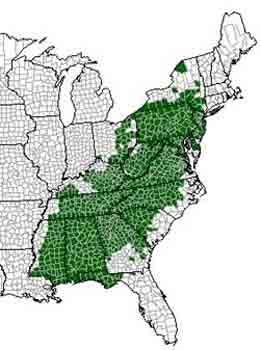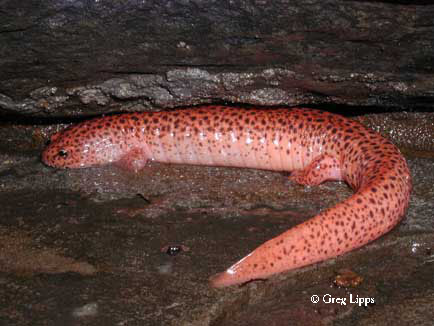
Northern Red Salamander
(Pseudotriton ruber ruber)
 |
 |
|
|
Distribution of the Red Salamander (from the AR MI Atlas)
|
An adult Northern Red Salamander.
|
|
Description: A stout, large (4”-8”) salamander. Ground color is reddish-orange, irregularly peppered with large numbers of black spots. The pupils of the eyes are colored yellow. Younger individuals are the most brightly colored, often described as crimson. Older animals are orange to purplish-brown with less distinct spotting. |
||
Distribution in Ohio: Limited to the eastern half of the state. |
||
|
|
||
Status in Ohio: Uncommon to locally abundant. |
||
|
|
||
Habitat: Found in and around springs, seeps, and primary headwater streams, where they usually remain hidden under leaf litter, logs, rocks, or underground. |
||
|
|
||
Life history: Courtship and breeding presumably occur in winter. Eggs are attached singly to the undersides of rocks or other structures in concealed locations and may be submerged underwater. Newly hatched larvae have been observed in March and complete metamorphosis at 27-31 months of age. |
||
|
|
||
Conservation: Red Salamander populations rely on sources of groundwater, such as springs, seeps, and headwater streams. Their permeable skin makes them especially susceptible to pollution, such as pesticides, herbicides, runoff, and acid mine drainage. Removal of trees around springs, seeps, and headwater streams negatively impacts populations by increasing temperatures and evaporation. |
||
Last modified:
|
Ohio Amphibians · Ohio Salamander Web · Ohio Salamander Species · Amphibian Habitats · Salamander Monitoring |
|